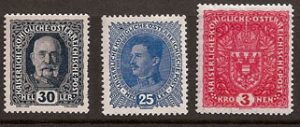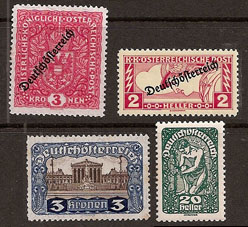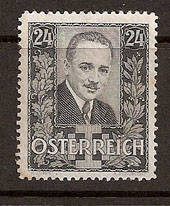Austria before Annexation in 1938
by Walter R. Roberts
A previous essay (American Diplomacy, February 2012) described Austria’s annexation by Germany on March 11, 1938. This article will deal with the events leading to that fateful day when Austria disappeared from the map.
I.
At the time of Austria ’s annexation, the country was ruled since March 1933 by a fascist regime patterned after Benito Mussolini’s Italy. It was Chancellor Engelbert Dollfuss who turned Austria from a democracy to an authoritarian state. Slyly exploiting parliamentary gridlock, he dissolved the Austrian parliament and assumed dictatorial powers. He established a close personal relationship with Mussolini and copied Italy’s fascist governmental structure. Soon the Dollfuss regime was called austro-fascist.
In turning to Mussolini, Dollfuss also had foreign policy objectives. In January 1933, Adolf Hitler had assumed power in Germany and was known to be determined that Austria (his country of birth) be incorporated into Germany – a threat which Dollfuss deeply feared. To demonstrate his close relationship with the Austrian leader, Mussolini proclaimed in August 1933 an Italian guarantee of Austrian independence. I remember that this announcement was hailed by those in Austria who dreaded a potential union with Nazi Germany. On the other hand, those Austrians who wished to be united with Nazi Germany were deeply resentful of the Italian leader’s action. My father, a prescient man, who did not believe in Mussolini’s word, sent me to England to learn English.
Mussolini’s guarantee of Austrian independence annoyed Hitler, but he was not prepared to challenge Il Duce. In 1933, rearmament of Germany and the remilitarization of the Rheinland were on Hitler’s priority agenda which he knew would provoke France and also Britain. In these circumstances, he could not afford adding the opposition of Mussolini if he went after Austria.
II
Before Dollfuss assumed dictatorial powers, Austria was a democratic republic. It was declared such by the Austrian political leaders at the end of World War I and confirmed in 1919 by the Treaty of St.Germain which the victorious allies imposed on an Austria which was a very different country than the one that entered World War I in 1914.

Back in the autumn of 1918, Austria-Hungary, a country of 53 million people containing numerous nationalities, found itself on the losing side of a four-year world war. The country began to disintegrate. The various nationalities of the empire (Poles, Czechs, Slovaks, Croats, Slovenes and indeed Hungarians) rebelled and refused to participate in pursuing the war.
Poland, partitioned by Russia, Prussia and Austria in 1795, again emerged as a separate country on October 7, 1918, five weeks before the armistice that ended World War I. Czechoslovakia that had never existed as a country, was proclaimed a republic on September 26. The Kingdom of Serbs, Croats and Slovenes was established on October 6. These three new countries containing more than 40 million people became detached from Austria-Hungary. Indeed, they chose to join the victorious Western powers.
All this occurred while Karl I was still Emperor of Austria and King of Hungary and at a time when Hungary started to distance itself from Austria. On November 1, 1918, a left leaning government declared Hungary to be an independent republic.
Austria’s political leaders regarded these developments with deep concern. They met on October 21, 1918 in Vienna to prepare for the future of an Austria containing ten and a half million German-speaking people. On October 30, Karl Renner, one of the social-democratic leaders, was designated chancellor of Austria.

The other two stamps were issued by the government of Deutsch-Oesterreich in 1919.
Karl I, although not formally abdicating, relinquished power on November 11, 1918. On the following day, Austria declared itself a democratic republic that included all German speaking territories of the former Austro-Hungarian empire. The new republic was called Deutsch-Oesterreich. It also declared the new country to be a part of the Republic of Germany. (The modalities were to be worked out by Deutsch-Oesterreich and Germany and indeed there were detailed discussions between the two countries in February-March 1919 in Berlin.).
Was German-Austria which emerged from World War I eager to join Germany in a combined state? The answer is yes. Defeated in war, the country greatly reduced in size and population, the economy in tatters, the thought of joining Germany appeared attractive to the politicians. There was always a relatively small percentage of Austrians who regarded themselves as German in the first instance. But what made the difference in 1918 was that the Social-Democrats, a leftist party, took the lead in advocating a union with Germany. Its decision was not only based on the disastrous economic situation but also by the fact that the post- WWI German government was social-democratic. The right of center Austrian Christian -Socials were divided but in the end also voted for a union with Germany.
However, on September 10, 1919, Austria signed the Treaty of St.Germain in which the victorious Western powers decreed that Austria cede the German speaking territories of Suedtirol to Italy and of Bohemia to Czechoslovakia – territories inhabited by 4 million people. The treaty also prohibited Austria from calling itself Deutsch-Oesterreich and required it to be named the Republic of Austria. Like the Treaty of Versailles (with Germany) it also banned an Austrian-German union.

III.
Between 1919 and 1933, Austria was a democratic republic in which a combination of right-leaning parties opposed the country’s strong leftist party: the Social-Democrats. In the last free election in 1930, the Social-Democrats were the strongest party and therefore the President of Parliament was a Social-Democrat while the Chancellor (head of government) was a member of the right-wing coalition that constituted a majority in Parliament.
There was an additional element that made the Austrian political situation in those years particularly tense. As early as 1919, a rightwing para-military organization, the Frontkaempfer (frontfighters) was created. These individuals (mostly officers of the former Austrian army) organized themselves “ to assure order”. Jewish officers and men were not admitted. The group was disdainful of the Social-Democrats. This organization as well as other right-leaning para-military groups offered their support to the political parties of the right and in a couple of cases strong bonds were formed between political parties and these military groups.
The Social-Democratic party congress in 1922 proposed that a military organization be created to guard the Social-Democratic party. As one of the party leaders said, because the rightwing parties turn more and more to force, the Social-Democrats have no choice but to arm, too. Thus the Schutzbund was established which was to play a fatal role in the civil war of 1934.
Even earlier, in 1927, a major conflagration occurred between the Austrian government and the social-democratic opposition. It all started when a meeting of Social-Democrats in a pub in the Austrian province of Burgenland was attacked by a rightwing military organization. When the melee was over there were two dead and several wounded. The rightwing attackers were arrested and in a subsequent trial acquitted. That resulted in a bloody encounter between Social-Democrats and the Austrian police culminating in an attack on the Ministry of Justice on July 15,1927. The Justizpalast, as the Ministry’s building was called, was set on fire. A general strike was called by the Social-Democrats.
When the day was over, 89 people were dead – 85 were demonstrators and 4 were policemen. On the next day, a Saturday, the social-democratic party called on its members to stay calm but to continue the general strike. It also called on the government to resign blaming it for the deaths of 85 demonstrators and declaring its readiness to form a coalition government. The government refused. I was then 11 years old and still remember that the city was crippled because of the general strike and the absence of streetcar traffic. Once the general strike was called off, I took a streetcar to the burned Justice Ministry – a horrible recollection.
In 1930, Austria had its last free parliamentary elections. The result: The Social-Democrats had the largest representation (72). The Christian-Socials had 66 members. The Agriculture party had 9 representatives, the Heimatblock (patriotic front) had 8 and the PanGerman party had 10. (The Austrian National Socialist Party failed to elect a member, although Nazi leaning citizens were believed to have voted for the PanGerman Party).
In the next couple of years, the Austrian Nazis became more noticeable. People openly wore swastika emblems and even SA and SS uniforms. In local elections in April 1932, the Nazis gained seats, even in the mostly social-democratic city of Vienna. German Nazi leaders like Joseph Goebbels, Heinrich Himmler and Hermann Goering, while not yet in power, traveled to Vienna and addressed Nazi rallies.
IV.

On May 20, 1932, the rightwing Austrian coalition government was reshuffeled. Engelbert Dollfuss became the new chancellor. He had been a member of the previous government and was known as energetic, anti-Nazi and anti-socialist.
Dollfuss, as noted earlier, was an admirer of Benito Mussolini and the Italian leader’s authoritarian fascist system of government; he was determined to lead Austria in the same direction. In March of 1933, Dollfuss eliminated the Austrian parliament depriving the social-democrats of a vital political base. In the following months, he abolished the small communist party. He also prohibited the further functioning of the Schutzbund, the military organization of the social-democratic party. When the Austrian Nazis, in the spring of 1933, increased their opposition to the Dollfuss regime and committed serious acts of sabotage, the government declared the Austrian Nazi party an illegal organization. While the social-democratic party still existed, it was impotent. Its newspaper, the Arbeiter Zeitung, was censored by the government and often appeared with white pages — evidence that articles had been eliminated by the censors.
The final act in the destruction of the Austrian democratic republic came in February 1934. While the Schutzbund, the social-democratic party’s military adjunct, had been banned by the Dollfuss government in 1933, the organization was not disarmed. But early in 1934, the government started to confiscate Schutzbund weapons and on February 12 such a roundup took place in Linz. The Schutzbund leadership without authorization of the social-democratic party leadership resisted and battles ensued that spread to other parts of the country, including Vienna. My high school was located in the same district as one of the housing complexes that served as a Schutzbund base, and I remember hearing the exchange of fire. These skirmishes escalated to a civil war that lasted several days. The government using artillery – the Schutzbund had only lighter weapons – prevailed. Many members of the Schutzbund were arrested, put on trial and quickly court-martialed. Nine people were condemned to death and were hanged. The social-democratic party was banned; its leaders fled the country. Austro-fascism was in full control.
Five months later, on July 25, 1934, a year after the Austrian Nazi party had been banned by the Dollfuss government, Austrian Nazis, plotting underground, launched a putsch in Vienna and indeed throughout most of Austria. They assassinated Chancellor Dollfuss in his office. The putschists’ plan was to take over the Austrian government and then to unite it with Nazi Germany. But things did not evolve as planned by the Nazis. The Austrian authorities prevailed, the Nazi putschists were arrested and their leaders executed.
Most of the Austrian Nazi leaders had fled to Germany when the Austrian Nazi party was dissolved in 1933. They plotted the July 1934 putsch from Germany with Nazis who had hidden in Austria. It must therefore be assumed that Nazi party officials in Germany knew of the putschists’ plans. But the German government distanced itself immediately from the events in Austria. Learning that Mussolini had reinforced Italian troops at the Brenner Pass, the Nazi propaganda ministry instructed German media to announce that if Austrian putschists were to try to cross into Germany they would be sent to concentration camps. Conversely, if Austrian Nazis who had fled to Germany after the banning of the Austrian Nazi party were to try to return to Austria, they would be prevented by the German army from doing so. In addition, the German minister to Austria was summarily recalled to Berlin. Nazi Germany had distanced itself from the putsch and the Dollfuss assassination. In 1934, Hitler was not yet ready to move on Austria. He had other priorities and certainly did not wish to incur Mussolini’s enmity.
Dr.Kurt Schuschnigg, the Minister of Justice who organized the trials and executions of the Schutzbund leadership a few months before, became Chancellor and guided the country in the same direction as his predecessor Dollfuss. On the eve of Germany’s annexation of Austria in March 1938, Schuschnigg, mindful of Mussolini’s 1933 guarantee of Austria’s independence, phoned Il Duce. However, Mussolini refused to accept the call. The political and military situation in Europe had vastly changed since 1933 when Mussolini guaranteed Austria’s independence. With Britain and France pressuring Il Duce because of the Italian war in Abyssinia, Mussolini was in 1938 eager to ingratiate himself with Hitler.

While writing this article, a news item crossed my desk, entitled “Clear Perversions of Justice.” It reported that the Austrian parliament had adopted a law, effective March 1, 2012, to the effect that all those who were deprived of their democratic rights during the years 1933 to 1938 would have these rights reestablished and that all political punishments were rendered null and void. This law was passed unanimously by the present Austrian parliament which includes socialists and right of center parties.A small but significant measure to attempt to erase the dark years in Austria’s history in the nineteen thirties.![]()
I am again indebted to my friend, Hugo Portisch, for his magisterial Oesterreich 1.
I am also indebted to my friend and colleague George Jacobs for providing appropriate stamps for this article. He is renowned for connecting his devotion to philately with his experience as a noted engineer, diplomat and journalist.

